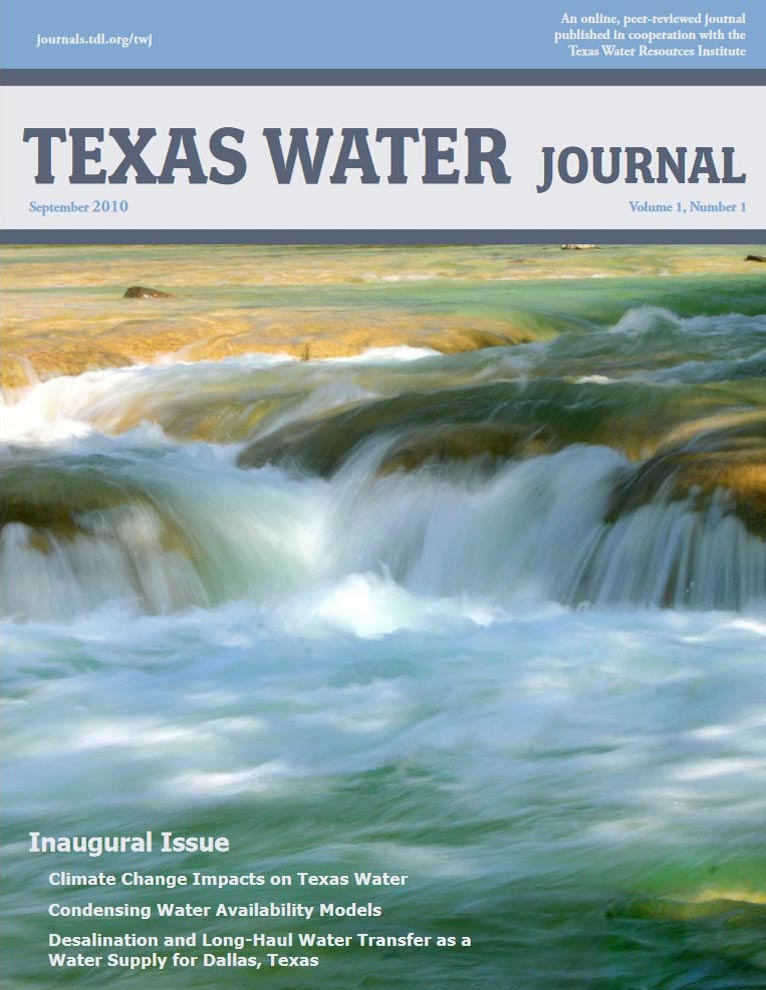Abstract
As existing water supplies become increasingly strained in some locations, water planners turn to alternative options to quench cities’ thirst. Among these options for inland cities is desalination of seawater or brackish groundwater with long-haul water transfer. Desalination using reverse osmosis membranes is the most common technology in use, yet high pressures required for operation make desalination an energy-intensive water supply option. The subsequent conveyance of desalinated water through long-haul pipelines also requires large amounts of energy. To analyze desalination and long-haul transfer as a drinking water supply, Dallas, Texas, was chosen as a test-bed with two scenarios: seawater desalination near Houston and brackish groundwater desalination near Abilene, both with long-haul transfer of desalinated water to Dallas. Combining the energy requirements for long-distance pumping with the energy demands for desalination, we estimate that desalination and long-haul transfer is nine to 23 times more energy-intensive per unit of water than conventional treatment of local surface water sources, an increase of 230 to 630 MWh/d for 20 million gal (75,700 m3). These results suggest that desalination and long-haul transfer as a water supply for Dallas is less sustainable, based on energy consumption, than use of local surface water sources or water conservation.
Citation: Stillwell AS, King CW, Webber ME. 2010. Desalination and long-haul water transfer as a water supply for Dallas, Texas: A case study of the energy-water nexus in Texas. Texas Water Journal. 1(1)33-41. Available from: https://doi.org/10.21423/twj.v1i1.1042.
References
Barta P. 2008 Mar 11. Amid water shortage, Australia looks to the sea. Wall Street Journal [Internet]. Available from: http://online.wsj.com/article/SB120518234721525073.html
Bertin JJ. 1987. Engineering fluid mechanics. Englewood Cliffs (NJ): Prentice-Hall, Inc. 528 p.
CAT. 2009. CAT Pumps. Minneapolis (MN): CAT Pumps. Available from: http://www.catpumps.com/select/pdfs/4K111.pdf
[CEC] California Energy Commission. 2005. California’s water-energy relationship. Sacramento (CA): California Energy Commission. 174 p. Available from: http://www.energy.ca.gov/2005publications/CEC-700-2005-011/CEC-700-2005-011-SF.PDF
City of Corpus Christi [Internet]. c2009. Corpus Christi (TX): City of Corpus Christi. Water resources: local water supply; [cited 2010 Apr 9]. Available from: http://www.cctexas.com/?fuseaction=main.view&page=1009
Dallas Water Utilities Department. 2009. The path to 2060: Dallas’ long range water supply plan. Dallas: Dallas Water Utilities Department.
Desalination & Water Reuse. 2009 Nov 8. Total world desalination capacity close to 60 million m3/d [Internet]. Surrey (UK): Faversham House Group; [cited 2010 Apr 10]. Available from: http://www.desalination.biz/news/news_story.asp?id=5121
[EPRI] Electric Power Research Institute. 2002a. Water & sustainability (Volume 3): U.S. water consumption for power production – the next half century. Palo Alto (CA): Electric Power Research Institute. 1006786. 57 p.
[EPRI] Electric Power Research Institute. 2002b. Water & sustainability (Volume 4): U.S. electricity consumption for water supply & treatment – the next half century. Palo Alto (CA): Electric Power Research Institute. 1006787. 93 p.
Galloway D, Jones DR, Ingebritsen SE. 1999. Land subsidence in the United States. Reston (VA): U.S. Geological Survey. 175 p.
Gleick PH, Cooley H, Katz D, Lee E, Morrison J, Palaniappan M, Samulon A, Wolff GH. 2006. The world’s water 2006-2007: the biennial report on freshwater resources. Oakland (CA): Pacific Institute. 392 p.
Herring JE, Hunt J, Crutcher JM, Labatt TW 3rd, Vaughan EG, McMahan LH, Ward JK. 2008. The future of desalination in Texas. Austin: Texas Water Development Board. 73 p.
Lattemann S, Hopner T. 2008. Environmental impact and impact assessment of seawater desalination. Desalination 220(1-3):1-15.
Lawler D, Benjamin M. Forthcoming. Physical and chemical treatment processes for water. New York: McGraw Hill.
Office of the Governor (TX). [Internet]. [cited 2009 Oct 1]. Austin: Office of the Governor. Seawater desalination in Texas. Available from: http://governor.state.tx.us/priorities/infrastructure/natural_resources/seawater_desalination_in_texas/
Stillwell AS, King CW, Webber ME, Duncan IJ, Hardberger A. 2009. Energy-water nexus in Texas. Austin : University of Texas at Austin, Environmental Defense Fund. 51 p.
Tadros E, Robins B. 2008 May 14. Wind farm vow to power desalination [Internet]. The Sydney Morning Herald; [cited 2009 Mar 16]. Available from: http://www.smh.com.au/news/environment/wind-farm-vow-to-power-desalination/2008/05/13/1210444436869.html
Texas Comptroller of Public Accounts [Internet]. [cited 2009 Oct 1]. Austin: Texas General Land Office. Texas in Focus: South Texas Infrastructure. Available from: http://www.window.state.tx.us/specialrpt/tif/southtexas/infrastructure.html
[Texas GLO]. Texas General Land Office [Internet]. [cited 2008 Dec 3]. Austin: Texas General Land Office. Maps, Research & Data, Geographic Information Systems Data. Available from: http://www.glo.state.tx.us/gisdata/gisdata.html
[TWDB] Texas Water Development Board [Internet]. [cited 2008 Dec 5]. Austin: Texas Water Development Board. GIS Data. Available from: http://www.twdb.state.tx.us/mapping/gisdata.asp
[TWDB] Texas Water Development Board. 2009. Austin: Texas Water Development Board Brackish Groundwater Dataset. [Obtained from: Personal Communication 2009 Oct 13]
U.S. Census Bureau. [Internet]. [cited 2010 Apr 10]. Washington DC: U.S. Census Bureau. General Demographic Characteristics, 2008 Population Estimates. Available from: http://factfinder.census.gov/servlet/QTTable?_bm=y&-context=qt&-qr_name=PEP_2008_EST_DP1&-ds_name=PEP_2008_EST&-CONTEXT=qt&-tree_id=808&-geo_id=04000US48&-search_results=01000US&-format=-_lang=en
[US EIA] U.S. Energy Information Administration [Internet]. 2010 Mar. Washington DC: U.S. Energy Information Administration. Independent Statistics and Analysis, Texas Electricity Profile. 2008 edition; [cited 2010 Apr 10]. Available from: http://www.eia.doe.gov/cneaf/electricity/st_profiles/texas.html
[US EPA] U.S. Environmental Protection Agency [Internet]. [modified 2010 Jul 19]. Washington DC: U.S. Environmental Protection Agency. Clean Energy, eGRID; [cited 2008 Dec 3]. Available from: http://www.epa.gov/cleanenergy/energy-resources/egrid/index.html
[USGS] U.S. Geological Survey, Earth Resources Observation and Science Center. [Internet]. [modified 2009 Oct 20]. Sioux Falls (SD): U.S. Geological Survey, Earth Resources Observation and Science Center; GTOPO30; [cited 2008 Dec 3]. Available from: http://eros.usgs.gov/#/Find_Data/Products_and_Data_Available/gtopo30_info
Van der Bruggen B, Vandecasteele C. 2002. Distillation vs. membrane filtration: overview of process evolutions in seawater. Desalination 143(3):207-218.
Ward JK, Mullican WF 3rd, and Brittin CL. 2007. Water for Texas 2007. Austin: Texas Water Development Board.
Zander AK, Elimelech M, Furukawa DH, Gleick P, Herd K, Jones KL, Rolchigo P, Sethi S, Tonner J, Vaux HJ, Weis JS, Wood WW. 2008. Desalination: a national perspective. Washington DC: National Academies Press.

This work is licensed under a Creative Commons Attribution 4.0 International License.
Copyright (c) 2010 Ashlynn S. Stillwell, Carey W. King, Michael E. Webber

